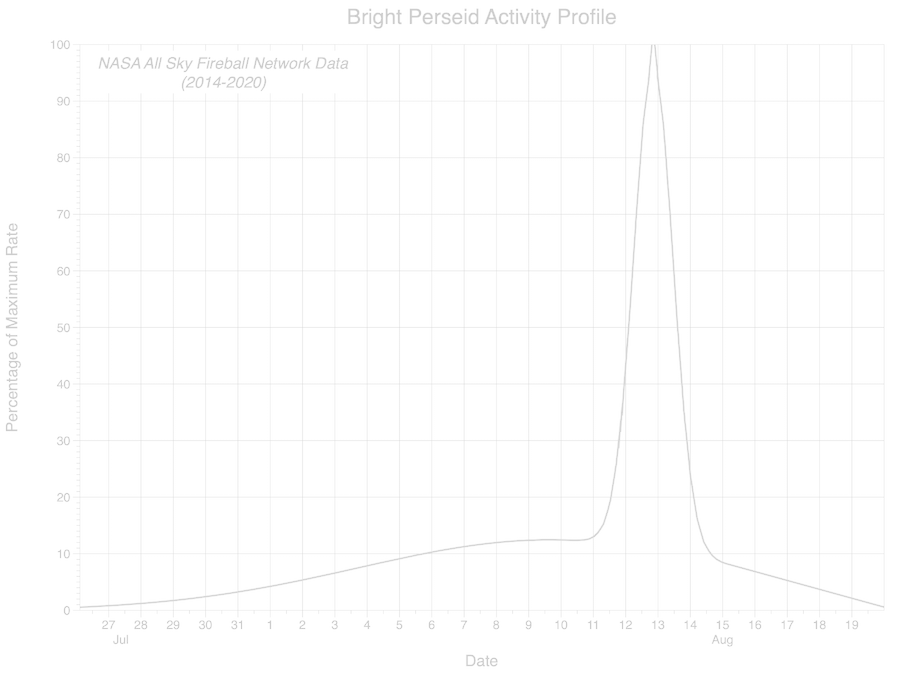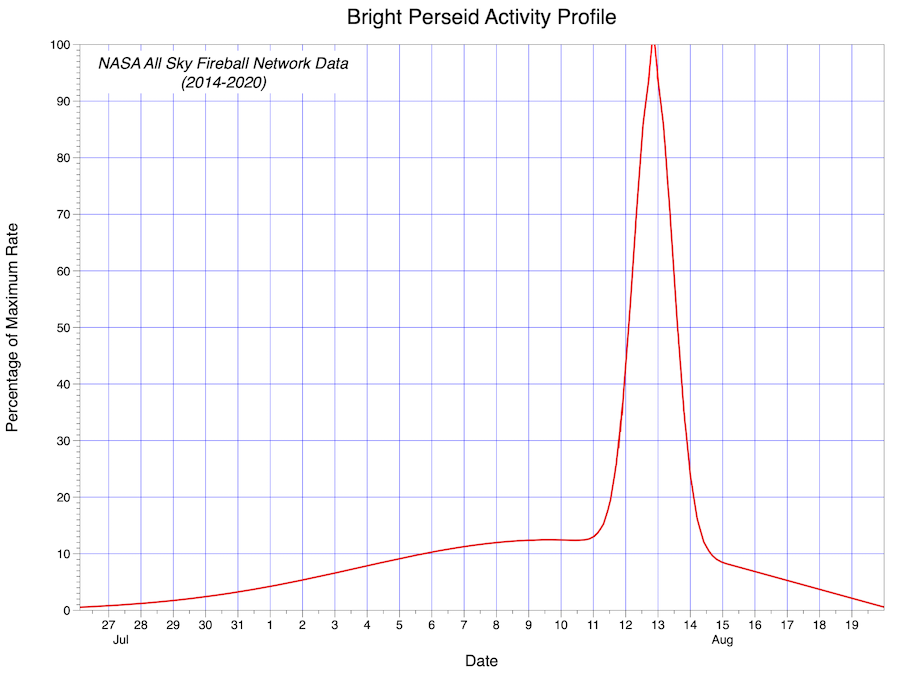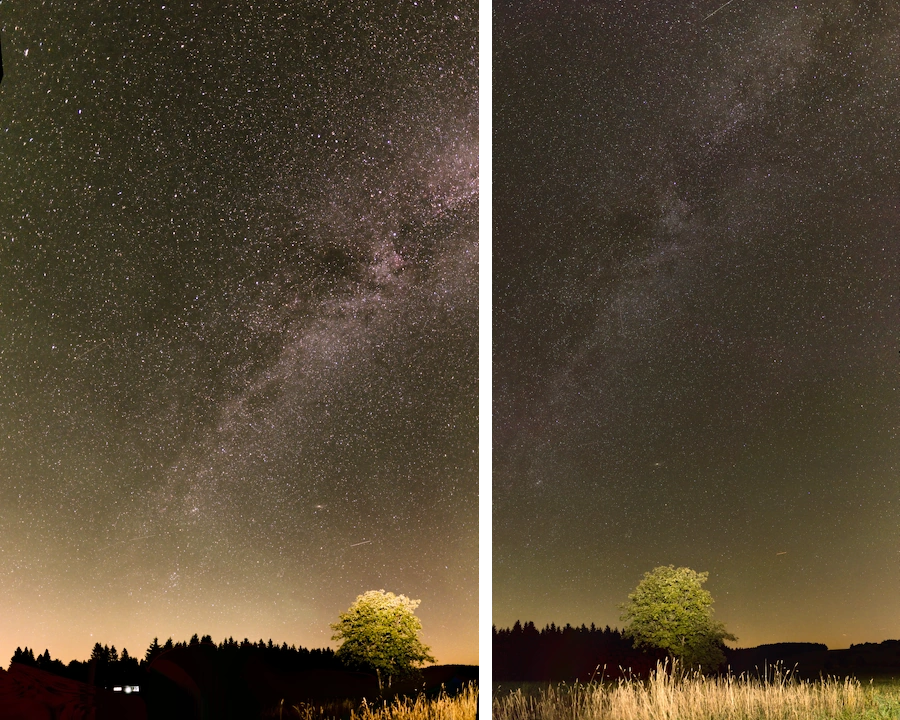ENG | Nighttime Photography: Perseids, Unravelling Mysteries
Building on our previous exploration of the Perseids meteor shower, this sequel delves deeper into the specifics of nighttime photography during this celestial event. Several questions arose from our last discussion, and in this post, I will unravel the mysteries and provide clarity on those intriguing topics.
Something for Curious Software Developers
For those curious about the calculations and Python scripts I used in deriving some of the insights shared in this article, feel free to explore this GitHub gist. It provides the raw code and comments to guide you through my thought process.
1. Evaluating the 500 / focal length Rule
Question:
How effective is the rule of 500 / focal length in preventing star trails?
Answer:
Surprisingly, shorter exposure times are often required than what the rule suggests. For instance, for a 26MPix camera equipped with a 35mm lens (considering FF equivalence), a star would move by a single pixel in just 2.25 seconds. Using the rule, 500 divided by 35 yields 14.3 seconds, which is roughly six times longer. In reality, stars might not appear pixel-sharp, especially with a fully open aperture in warm summer air, but this discrepancy might be something to consider.
Piece of (pseudo)-code is:
1
2
3
4
5
6
7
8
9
10
11
12
13
14
15
16
17
18
# For focal length in meters and shutter speed in seconds, return trail length
# on a sensor in meters. Do not use long shutter speed times longer than six
# hours, star will get behind a camera
def star_trail_length(focal_length: float, shutter_speed: float) -> float:
radians_per_second = 2.0 * math.pi / (24 * 60 * 60) # Earth rotation speed
radians = radians_per_second * shutter_speed # Earth rotation angle
# tan(radians) = trail_length / focal_length ==>
trail_length: float = math.tan(radians) * focal_length
return trail_length
# These are constants for Fujifilm X100V APS-C camera
sensor_width = 23.5e-3
focal_length = 23.0e-3
image_width = 6240
pixel_size = sensor_width / image_width
star_trail_pixels_per_second = star_trail_length(focal_length, 1.0) / pixel_size
star_trail_seconds_per_pixel = 1.0 / star_trail_pixels_per_second
2. Sky Coverage at Given Focal Lengths
Question:
How much of the sky is captured at a specific focal length?
Answer:
To answer this, I considered the camera sensor’s specifications and conducted a Monte-Carlo simulation in Python. Here’s a breakdown of my findings:
Sensor Dimensions by Camera Format
| Camera Format | Sensor width[mm] | Sensor Height[mm] |
|---|---|---|
| FF | 36.0 | 24.0 |
| APS-C | 23.5 | 15.6 |
| Micro 4/3 | 17.3 | 13.0 |
| 1” | 12.8 | 9.6 |
Sky Coverage by Focal Length
| Camera Format | Focal Length[mm] | HFov[°] | VFoV[°] | Sky Coverage[%] |
|---|---|---|---|---|
| Full Frame | 14 | 104.3 | 81.2 | 34.0 |
| Full Frame | 18 | 90.0 | 67.4 | 25.4 |
| Full Frame | 24 | 73.7 | 53.1 | 17.3 |
| Full Frame | 28 | 65.5 | 46.4 | 13.6 |
| Full Frame | 35 | 54.4 | 37.8 | 9.5 |
| Full Frame | 50 | 39.6 | 27.0 | 4.9 |
| APS-C | 14 | 80.0 | 58.2 | 20.1 |
| APS-C | 16 | 72.6 | 52.0 | 16.6 |
| APS-C | 18 | 66.3 | 46.9 | 13.8 |
| APS-C | 23 | 54.1 | 37.5 | 9.3 |
| Micro 4/3 | 8 | 94.5 | 78.2 | 30.7 |
| Micro 4/3 | 12 | 71.6 | 56.9 | 18.0 |
| Micro 4/3 | 14 | 63.4 | 49.8 | 13.8 |
| Micro 4/3 | 18 | 51.3 | 39.7 | 9.3 |
| Micro 4/3 | 20 | 46.8 | 36.0 | 7.9 |
| Micro 4/3 | 25 | 38.2 | 29.1 | 5.4 |
3. Decoding the Color Transition of Meteorite Trails
Question:
Why do star trails initiate with a green hue and later transition to purple?
Answer:
This fascinating phenomenon can be attributed to the same reason the aurora borealis (Northern Lights) showcases these colors.
Upon entering the atmosphere, meteors begin to burn up due to the intense friction with air particles. As they ionize the air molecules in their path, the color emitted depends on which gas is being ionized.
Green: At altitudes of around 100km, oxygen is the predominant atmospheric gas. When ionized, oxygen emits a greenish hue, which is why we often observe a green streak initially.
Red/Purple: As the meteor descends to altitudes below 100km, the concentration of nitrogen increases. Ionized nitrogen can give off red and purplish hues, especially when combined with residual ionized oxygen.
Thus, the gradient from green to purple is a result of the changing composition of atmospheric gases encountered by the meteor as it descends through different altitude layers.
4. The Best Dates to Witness the Perseids
Question:
While the peak for the Perseids is on the 13th of August, how do the other days compare? Specifically, how viable are the days leading up to and following the peak? Various media suggests that Perseids are visible for month without any further details.
Answer:
A day before or after the peak is still promising, though the frequency is roughly halved. Beyond this window, chances diminish significantly, dropping to about 12 events per hour by early August.
The graph below paints a clearer picture:

 This chart shows expected levels of Perseid activity for July and August 2021, relative to the peak on Aug. 11-13, ignoring the effects of the Sun, Moon, and clouds. All times are in UTC. Credits: (NASA/MEO/Bill Cooke)
This chart shows expected levels of Perseid activity for July and August 2021, relative to the peak on Aug. 11-13, ignoring the effects of the Sun, Moon, and clouds. All times are in UTC. Credits: (NASA/MEO/Bill Cooke)
5. Comparison of Fujifilm X100V and Panasonic G80 image quality
Question
How does micro four thirds (MFT, M43) and APC-S sensor compare in terms of image quality. What about Panasonic 20mm/f1.7 and Fujifilm’s X100V lens?
Answer
This evaluation wasn’t conducted under identical conditions for both cameras; sky haze could be a factor influencing contrast to some degree. Also, I initially overlooked Fujifilm’s Focus Check feature, affecting my assessment of its focus capabilities. Despite these factors, the general observations and comparisons are believed to be valid.
Also note that camera settings might are not ideal and tests with different exposure time, aperture, and ISO settings were not conducted. These settings were just good enough for Fujifilm X100V and used for Panasonic G80. Higher aperture can be also used to minimize aberation, astigmatism and vignetting. These issues are worse than star trails (especially because image is quite large panorama downsized several times and especially when results are targeted to social media).
Lens and Sharpness
My current stance is that the Panasonic’s 20mm/f1.7 lens excels in minimizing coma aberration and blurriness of bright stars, but suffers from vignetting.
Coma aberation and/or astigmatism is a problem affecting only night time photographs with bright point sources of light, such as distant streets lamps and bright stars. It’s present in images of both cameras, but on Fujifilm it cannot be overlooked. This aberation is problematic for automatic keypoint detection in panorama stitching and also makes stars further from image center bigger and brighter.
During my Milky Way panorama shoot, I was unaware of Fujifilm’s ‘Focus Check’ feature, a more suitable tool for achieving perfect sharpness than focus peaking.
Sensor and Noise
The Panasonic G80, released in 2016, likely utilizes the same sensor as older models, potentially based on 10-year-old technology. The sensor in the X100V is an X-Trans 4 from 2018. Both have the same pixel density, but the X100V boasts a higher resolution and sensor area. The X100V also features a backside-illuminated sensor, claimed to offer roughly a one F-stop advantage.
JPEGs from the Fujifilm X100V perform reasonably well at ISO6400, whereas, those from the Panasonic G80 show noticeable noise and numerous hot pixels even at ISO3200, both using 10 seconds exposure.
In RawTherapee, the Panasonic absolutely requires dark frames for hot pixel correction, which also significantly aids in noise reduction. The Fujifilm doesn’t seem to require this step. The Panasonic also needs somewhat higher noise reduction levels.
The compensation for vignetting makes this problem even worse. The overall noise floor reduces contrast and color saturation in dark parts of images, such as Milky Way.
Panorama Comparison
Image below illustrates the difference, although it’s not perfect comparison. The photos were taken on different nights and different times (21st August around 23:00, 10th September around 21:30), and Panasonic was set to ISO3200 versus ISO6400 for the Fujifilm. Stars are much less visible in the Panasonic panorama, because it is shaper, but as mentioned earlier, I used focus peeking on Fujifilm. Also development process is not the same. Milky way and it’s colors is somewhat lost in the noise.
 Comparison of Fujifilm X100V and Panasonic G80
Comparison of Fujifilm X100V and Panasonic G80
Conclusion
It’s important to know your camera, lenses and their technical limits and how to overcome them. Comparison is not ideal, but I learned something.